
In a welcome respite for residents grappling with hazardous pollution levels, New Delhi and its adjoining areas experienced overnight rains, significantly improving air quality by reducing concentrations of harmful particles. The alleviation comes after a week of severe pollution, where the national capital earned the dubious distinction of being the world’s most polluted city until Thursday.
The levels of pollutants PM 2.5 and PM10 saw a considerable drop after 4 am, bringing some relief to the pollution-stricken region. According to data from the government’s air-quality monitoring agency SAFAR, the overall air quality in Delhi at 7 am today was recorded at 407. While this marks an improvement, several areas, including Ashok Vihar (443), Anand Vihar (436), Bawana (433), Rohini (429), and Punjabi Bagh (422), continue to grapple with elevated pollution levels.
Neighboring cities such as Noida, Faridabad, Gurugram, and Ghaziabad also witnessed high air quality index (AQI) readings, indicating the widespread impact of the pollution crisis. Noida’s average AQI was 475, Faridabad recorded 459, Gurugram measured 386, and Ghaziabad reported 325.
The Delhi government, in its ongoing efforts to combat the pollution menace, is exploring various measures, including discussions with the Indian Institute of Technology (IIT) on the possibility of artificial rain across the capital. The Aam Aadmi Party ministers were observed on the ground inspecting the execution of anti-pollution initiatives on Thursday night.
As the city grapples with this environmental challenge, the Supreme Court is set to review existing measures aimed at improving air quality. The court will consider further tightening rules on road traffic and discuss the role of dust raised from construction, a significant contributor to the pollution problem in the city.
Gufran Beig, the founder director of SAFAR, highlighted the need for heavy and widespread rain to effectively wash away pollutants. He cautioned that light rains might exacerbate the situation. Beig also pointed out that the current airflow is carrying smoke from crop residue burning in Punjab and Haryana to Delhi, compounding the city’s pollution woes.
While the light rains offer a brief reprieve, the battle against pollution in Delhi remains a complex challenge, requiring sustained efforts and innovative solutions to ensure the well-being of its residents.
Sources By Agencies




